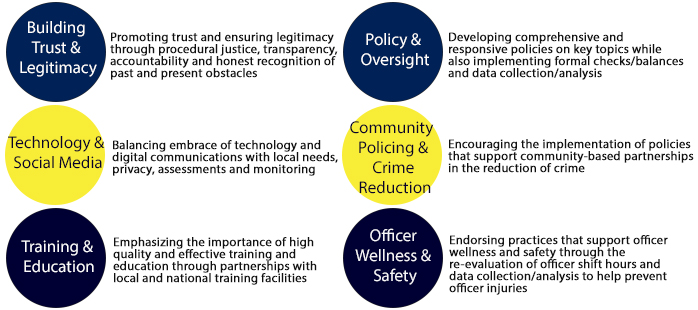
President’s Task Force on 21st Century Policing
One year ago today, President Obama issued an Executive Order creating the President’s Task Force on 21st Century Policing “to identify the best means to provide an effective partnership between law enforcement and local communities that reduces crime and increases trust.” The President appointed a diverse group of law enforcement leaders, academics, youth leaders, and advocates to represent the varied perspectives on law enforcement in America.
The Task Force organized a national information gathering effort over six weeks. The tour provided an opportunity to hear directly from the American people about their recommendations for police reform and to hear testimony from over 100 experts. The Task Force also collected over 1000 pages of written input from the public.
Armed with the ideas and experiences of the best minds in the field, the Task Force unanimously developed nearly 60 recommendations to pave the path toward the Administration’s two-part goal: crime reduction and building trust between law enforcement and the communities they serve. (Read the Final Report of the President’s Task Force on 21st Century Policing).
The Plan
The Task Force report emphasizes trust and legitimacy as the foundation for 21st Century policing. It calls on officers to serve as “guardians” instead of “warriors” and identifies the need for more community policing and a commitment to procedural justice (both within police organizations and in police-community interactions).
The Task Force recommendations cover items for federal, state, local and tribal government and the communities they serve.

Progress
Law enforcement leaders across the country have endorsed the Task Force approach. In July, the White House and the Department of Justice hosted law enforcement leaders at the Forum on Community Policing. During the meeting, these leaders requested a guidebook to assist in quickly implementing Task Force recommendations. (Read the President’s Task Force on 21st Century Policing Implementation Guide: From Recommendations to Action).
State, local and tribal law enforcement across the country engaged with the ideas and action items in the Task Force Report, adopting recommendations and plans for an agency’s unique needs and challenges. As they continue to make progress, the Department of Justice’s Office of Community Oriented Policing Services (COPS Office) will continue to feature these activities and successes.
Major law enforcement organizations (including International Association of Chiefs of Police, the National Organization of Black Law Enforcement Executives, Major Cities Chiefs Association, the Police Executive Research Forum, the National Sheriffs’ Association, Major County Sheriffs, the National Law Enforcement Officers Memorial Fund, the U.S. Conference of Mayors, the Police Foundation, and the Hispanic American Police Command Officers Association signed up to offer support: circulating key information to their 800,000 members and leading various projects to Task Force ends.
Within six months of the release of the Task Force report, notable successes include:
- 5,000 law enforcement personnel trained on the Task Force report
- 50,000 law enforcement personnel trained on key Task Force report themes (e.g., procedural justice, fair and impartial policing)
- Over $160 million in federal spending slated for Task Force related projects
- A new Policing Practices and Accountability Initiative within the DOJ COPS Office that will provide technical assistance and crisis services to law enforcement agencies
- The State of Illinois passing legislation that advances key elements of the Task Force report including expanding the use of body cameras, requiring independent and external investigations of deadly force, and training on civil rights, human rights and cultural competency
- The Police Data Initiative through which 27 jurisdictions are publicly releasing criminal justice data that had not been previously released. http://publicsafetydataportal.org/
- The issuance of guidance on “Identifying and Preventing Gender Bias in our Response to Sexual Assault and Domestic Violence.” http://www.justice.gov/opa/file/799476/download
The Year Ahead
In the coming year, the Administration will continue to work with law enforcement partners and communities to realize the vision of the Task Force report. New research and resources will fuel the implementation process while focus groups and feedback will inform decisions and course corrections.
There is still a long road ahead for law enforcement and communities committed to implementing Task Force recommendations, but with so many change agents in the field working together, there is no doubt that the current community policing movement will succeed.
And, as President Obama said when he spoke to the International Association of Chiefs of Police in October:
“I am convinced that progress comes together when we work together, and we work together best when we’re willing to understand one another -- when, instead of having debates over talk radio, we stop and listen to each other so that we can empathize with the father who fears his son can’t walk home without being mistaken for a criminal; and when we sympathize with the wife who can’t rest until her husband walks through the front door at the end of his shift.”

